An Analysis of Fixed-Wing Stall-Type Accidents in the United States
Abstract
:1. Introduction
2. Materials and Methods
2.1. Accidents Prior to 1982 (1962–1981)
2.2. Accidents between 1982 and before 2008
2.3. Accidents after 2008
3. Results
3.1. Accidents Prior to 1982 (1962–1981)
3.2. Accidents between 1982 and before 2008
3.3. Accidents after 2008 (2008–2020)
3.4. Overall Results
3.5. Uncategorized Events
4. Discussion
Funding
Data Availability Statement
Conflicts of Interest
Appendix A
| Code | Meaning | Code | Meaning |
|---|---|---|---|
| 0 | Hail damage to aircraft | N6 | Collided with runway or approach lights |
| 1 | Lightning strike | N7 | Collided with airport hazard |
| 2 | Evasive maneuver | N8 | Collided with animals |
| 3 | Uncontrolled altitude deviations | N9 | Collided with crop |
| 4 | Ditching | NA | Collided with flagman, loader |
| 5 | Missing aircraft, not recovered | NB | Collided with ditches |
| 6 | Miscellaneous | NC | Collided with snowbank |
| 7 | Undetermined | ND | Collided with parked aircraft |
| A | Ground-water loop-swerve | NE | Collided with automobile |
| B | Dragged wingtip, pod, or float | NF | Collided with dirt bank |
| C | Wheels-up | NY | Collided with object |
| D | Wheels-down landing in water | P | Bird strike |
| E | Gear collapsed | Q | Stall |
| F | Gear retracted | Q1 | Stall/spin |
| G | Hard landing | Q2 | Stall/spiral |
| H | Nose over/down | Q3 | Stall/mush |
| I | Roll over | R | Fire or explosion |
| J | Overshoot | R0 | Fire or explosion in flight |
| K | Undershoot | R1 | Fire or explosion on ground |
| L | Collision with aircraft | S | Airframe failure |
| L0 | Collision with aircraft—both in flight | S0 | Airframe failure in flight |
| L1 | Collision with aircraft—one airborne | S1 | Airframe failure on ground |
| L2 | Collision with aircraft—both on ground | T | Engine tearaway |
| M | Collision with ground/water | U | Engine failure or malfunction |
| M0 | Controlled collision with ground/water | V | Propeller/rotor failure |
| M1 | Uncontrolled collision with ground/water | V1 | Propeller failure |
| N | Collided with unspecified object | V2 | Tail rotor failure |
| N0 | Collided with wires/poles | V3 | Main rotor failure |
| N1 | Collided with trees | W | Propeller/rotor accident to person |
| N2 | Collided with residence(s) | X | Jet intake/exhaust accident to person |
| N3 | Collided with building(s) | Y | Propeller/jet/rotor blast |
| N4 | Collided with fence, fenceposts | Z | Turbulence |
| N5 | Collided with electronic towers |
References
- Flight Standards Service. Private Pilot—Airplane Airman Certification Standards; FAA: Washington, DC, USA, 2018.
- Hoffman, W.C.; Walter, M.H. General Aviation Pilot Stall Awareness Training Study; U.S. Department of Transportation: Washington, DC, USA, 1976.
- Committee on Government Operations. FAA Certification of Light Aircraft, 1st ed.; U.S. Government Printing Office: Washington, DC, USA, 1973.
- Anderson, S.B. Historical Overview of Stall/Spin Characteristics of General Aviation Aircraft. J. Aircr. 1979, 16, 455–461. [Google Scholar] [CrossRef]
- Belcastro, C.M.; Jacobson, S.R. Future Integrated Systems Concept for Preventing Aircraft Loss-of-Control Accidents. In AIAA Guidance, Navigation and Control Conference; AIAA: Toronto, ON, Canada, 2010. [Google Scholar]
- Lee, D.-C.; Nagati, M.G. Momentum Vector Control for Spin Recovery. J. Aircr. 2004, 41, 1414–1423. [Google Scholar] [CrossRef]
- Venkateswara, R.D.M.K.K.; Go, T.H. Optimization of Aircraft Spin Recovery Maneuvers. Aerosp. Sci. Technol. 2019, 90, 222–232. [Google Scholar] [CrossRef]
- Bunge, R.; Kroo, I. Automatic Spin Recovery with Minimal Altitude Loss. In 2018 AIAA Guidance, Navigation, and Control Conference; AIAA: Kissimmee, FL, USA, 2018. [Google Scholar]
- de Voogt, A.J.; van Doom, R.R. Accidents Associated with Aerobatic Maneuvers in U.S. Aviation. Aviat. Space Environ. Med. 2009, 80, 732–733. [Google Scholar] [CrossRef] [PubMed]
- Lambregts, A. Gregg Nesemeier, Richard Newman, and James Wilborn. Airplane Upsets: Old Problem, New Issues. In AIAA Modeling and Simulation Technologies Conference and Exhibit; AIAA: Honolulu, HI, USA, 2008. [Google Scholar]
- Belcastro, C.M.; Foster, J.V. Aircraft Loss-of-Control Accident Analysis. In AIAA Guidance, Navigation and Control Conference; AIAA: Toronto, ON, Canada, 2010. [Google Scholar]
- Taylor, A.; Dixon-Hardy, D.W.; Wright, S.J. Simulation Training in U.K. General Aviation: An Undervalued Aid to Reducing Loss of Control Accidents. Int. J. Aviat. Psychol. 2014, 24, 141–152. [Google Scholar] [CrossRef] [Green Version]
- Flight Standards Service. Flight Instructor Practical Test Standards for Airplane; FAA: Washington, DC, USA, 2012.
- Federal Aviation Administration. Stall and Spin Awareness Training; AC 61-67C; FAA: Washington, DC, USA, 2000.
- Veillette, P.R. Reexamination of Stall and Spin Prevention Training. Transp. Res. Rec. 1993, 26–33. [Google Scholar]
- Advani, S.; Field, J. Upset Prevention and Recovery Training in Flight Simulators. In Proceedings of the AIAA Modeling and Simulation Technologies Conference, Portland, OR, USA, 8–11 August 2011. [Google Scholar]
- O’Hare, D.; Wiggins, M.; Batt, R.; Morrison, D. Cognitive Failure Analysis for Aircraft Accident Investigation. Ergonomics 2007, 37, 1855–1869. [Google Scholar] [CrossRef]
- Fala, N. A Review of Stall-Type Accident Statistics over the Past Fifty Years. In Proceedings of the Human Factors and Ergonomics Society Annual Meeting, Los Angeles, CA, USA, 5–9 October 2020; pp. 127–128. [Google Scholar]
- National Transportation Safety Board. NTSB Accident Database. Available online: https://www.ntsb.gov/Pages/AviationQuery.aspx (accessed on 18 February 2022).
- Canfield, D.V.; Chaturvedi, A.K.; Dubowski, K.M. Carboxyhemoglobin and Blood Cyanide Concentrations in Relation to Aviation Accidents. Aviat. Space Environ. Med. 2005, 76, 978–980. [Google Scholar]
- Sen, A.; Akin, A.; Canfield, D.V.; Chaturvedi, A.K. Medical Histories of 61 Aviation Accident Pilots with Postmortem Ssri Antidepressant Residues. Aviat. Space Environ. Med. 2007, 78, 1055–1059. [Google Scholar] [CrossRef]
- Dulkadir, Z.; Chaturvedi, A.K.; Craft, K.J.; Hickerson, J.S.; Cliburn, K.D. Tricyclic Antidepressants Found in Pilots Fatally Injured in Civil Aviation Accidents. J. Forensic Sci. 2017, 62, 164–168. [Google Scholar] [CrossRef]
- Boyd, D.D. Causes and Risk Factors for Fatal Accidents in Non-Commercial Twin Engine Piston General Aviation Aircraft. Accid. Anal. Prev. 2015, 77, 113–119. [Google Scholar] [CrossRef] [PubMed]
- Ison, D.C. Comparative Analysis of Accident and Non-Accident Pilots. J. Aviat. Technol. Eng. 2015, 4, 20. [Google Scholar] [CrossRef]
- Politano, P.M.; Walton, R.O. Analysis of Ntsb Aircraft-Assisted Pilot Suicides: 1982–2014. Suicide Life -Threat. Behav. 2016, 46, 234–238. [Google Scholar] [CrossRef] [PubMed]
- Rao, A.H.; Marais, K. A State-Based Approach to Modeling General Aviation Accidents. Reliab. Eng. Syst. Saf. 2020, 193, 106670. [Google Scholar] [CrossRef]
- Zhang, X.; Mahadevan, S. Bayesian Network Modeling of Accident Investigation Reports for Aviation Safety Assessment. Reliab. Eng. Syst. Saf. 2021, 209, 107371. [Google Scholar] [CrossRef]
- Srinivasan, P.; Nagarajan, V.; Mahadevan, S. Mining and Classifying Aviation Accident Reports. In Proceedings of the AIAA Aviation 2019 Forum, Dallas, TX, USA, 17–21 June 2019. [Google Scholar]
- Tanguy, L.; Tulechki, N.; Urieli, A.; Hermann, E.; Raynal, C. Natural Language Processing for Aviation Safety Reports: From Classification to Interactive Analysis. Comput. Ind. 2016, 78, 80–95. [Google Scholar] [CrossRef] [Green Version]
- Anderson, C.; Smith, M.O. Qualitative Analysis of Loss of Control Aircraft Accidents Using Text Mining Techniques. Int. J. Aviat. Aeronaut. Aerosp. 2017, 4, 2. [Google Scholar] [CrossRef]
- Dong, T.; Yang, Q.; Ebadi, N.; Luo, X.R.; Rad, P. Identifying Incident Causal Factors to Improve Aviation Transportation Safety: Proposing a Deep Learning Approach. J. Adv. Transp. 2021. [Google Scholar] [CrossRef]
- Goh, Y.M.; Ubeynarayana, C.U. Construction Accident Narrative Classification: An Evaluation of Text Mining Techniques. Accid. Anal. Prev. 2017, 108, 122–130. [Google Scholar] [CrossRef]
- Boyd, D.D. A Review of General Aviation Safety (1984–2017). Aerosp. Med. Hum. Perform. 2017, 88, 657–664. [Google Scholar] [CrossRef]
- Zhang, X.; Srinivasan, P.; Mahadevan, S. Sequential Deep Learning from Ntsb Reports for Aviation Safety Prognosis. Saf. Sci. 2021, 142, 105390. [Google Scholar] [CrossRef]
- Rao, A.H.; Fala, N.; Marais, K. Analysis of Helicopter Maintenance Risk from Accident Data. In Proceedings of theAIAA Infotech@ Aerospace, San Diego, CA, USA, 4–8 January 2016. [Google Scholar]
- Goldman, S.M.; Fiedler, E.R.; King, R.E. General Aviation Maintenance-Related Accidents: A Review of Ten Years of NTSB Data; US Department of Transportation: Washington, DC, USA, 2002.
- Rao, A.H. A New Approach to Modeling Aviation Accidents; Purdue University: West Lafayette, IN, USA, 2016. [Google Scholar]
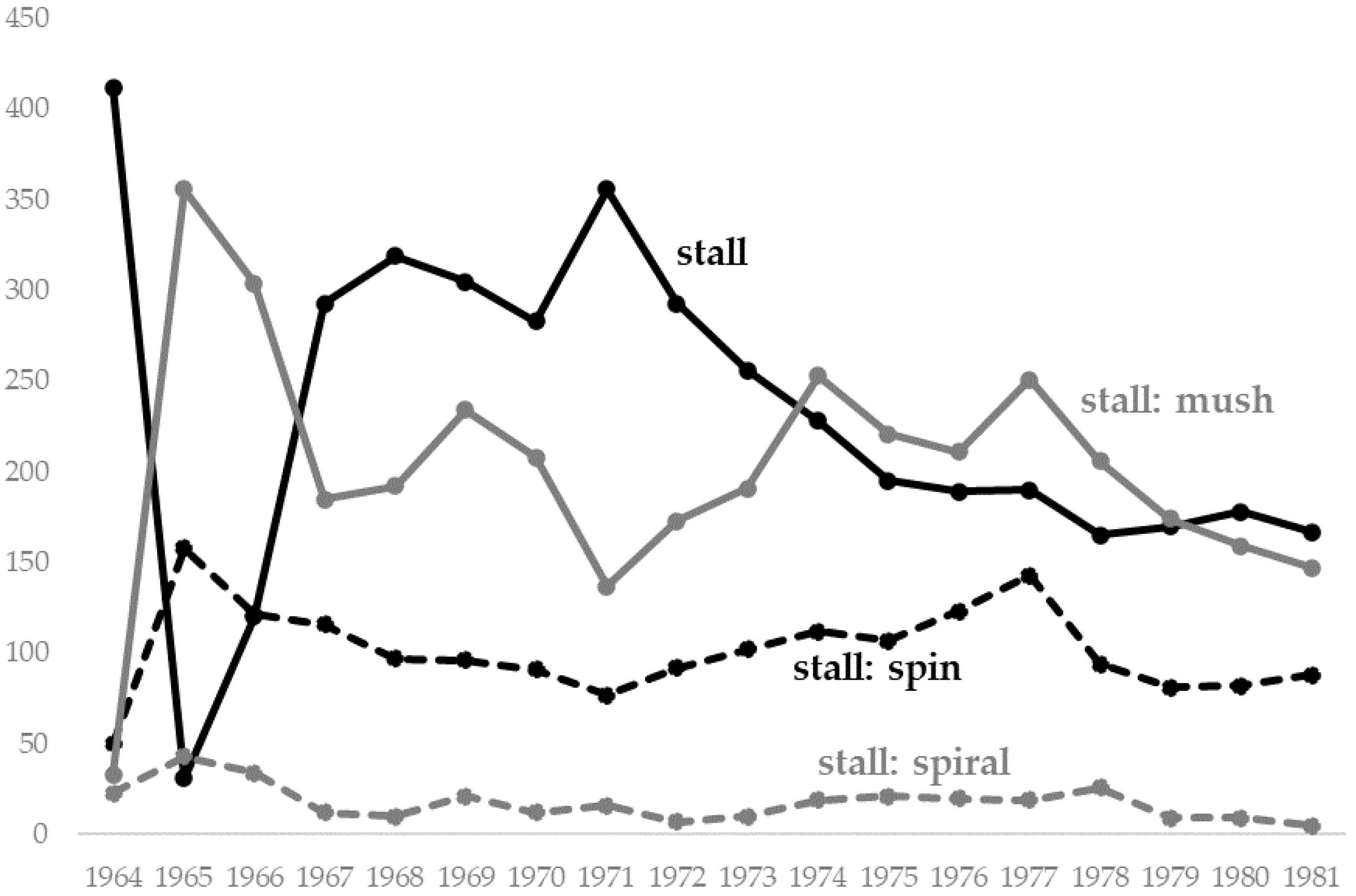
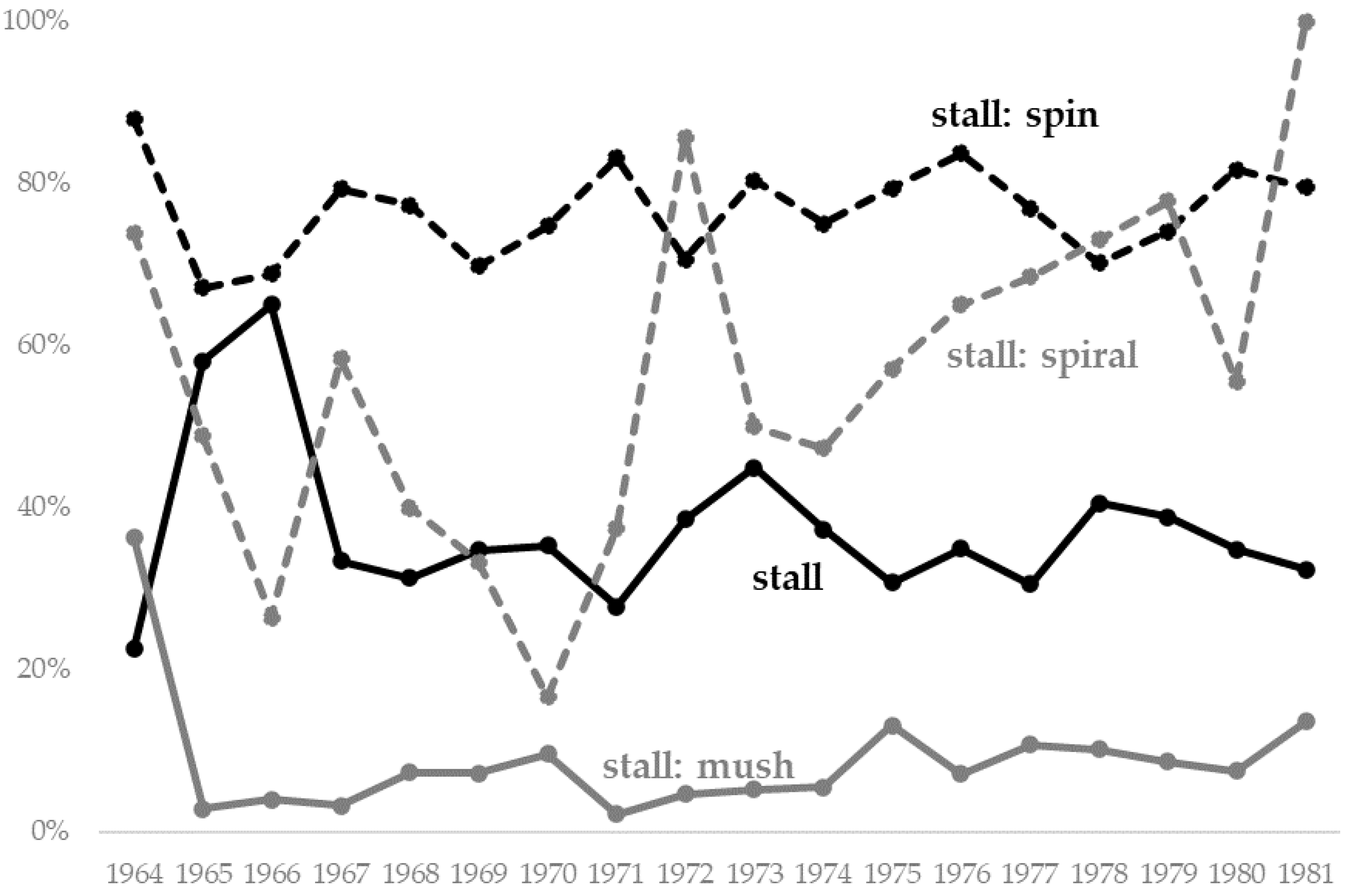
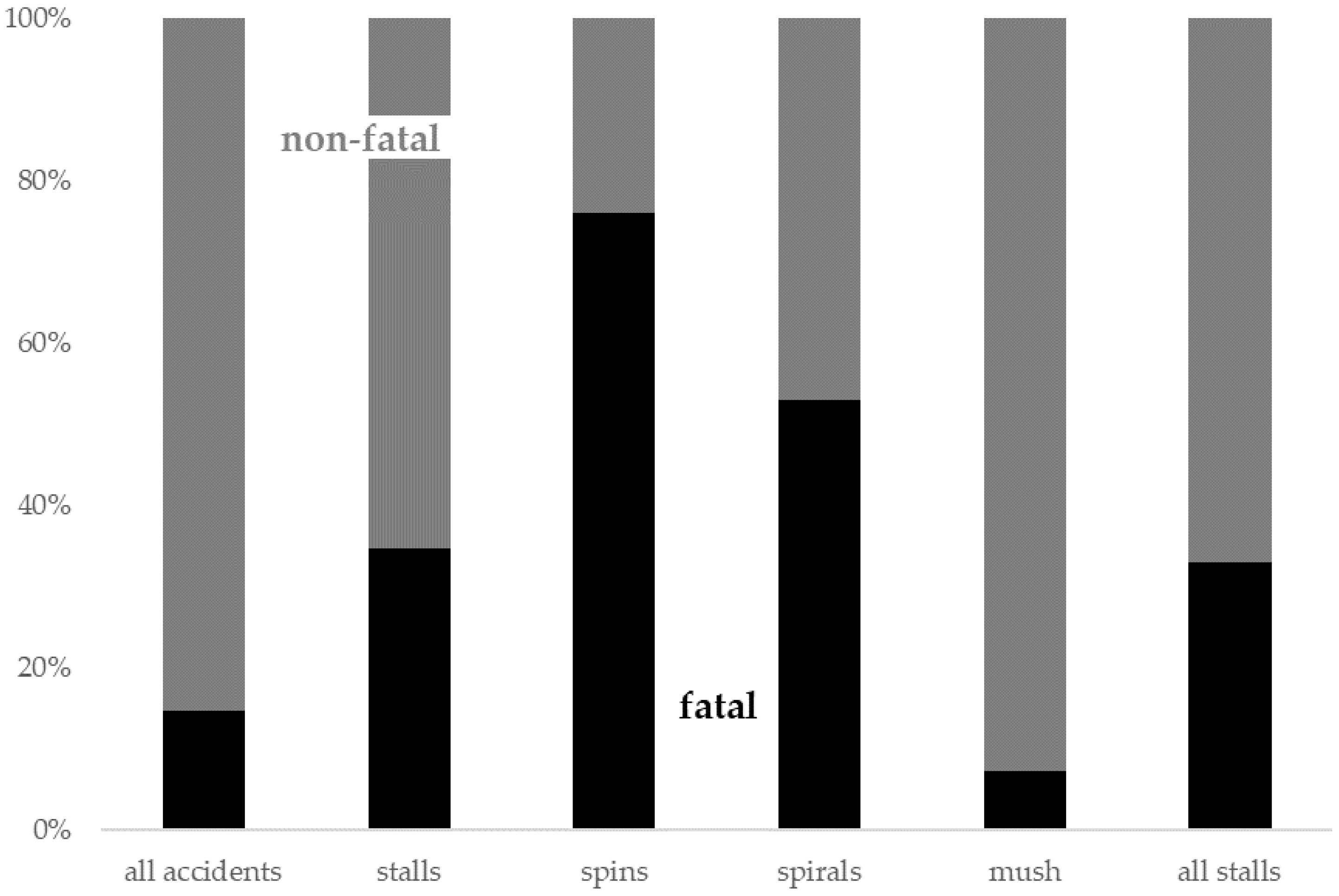
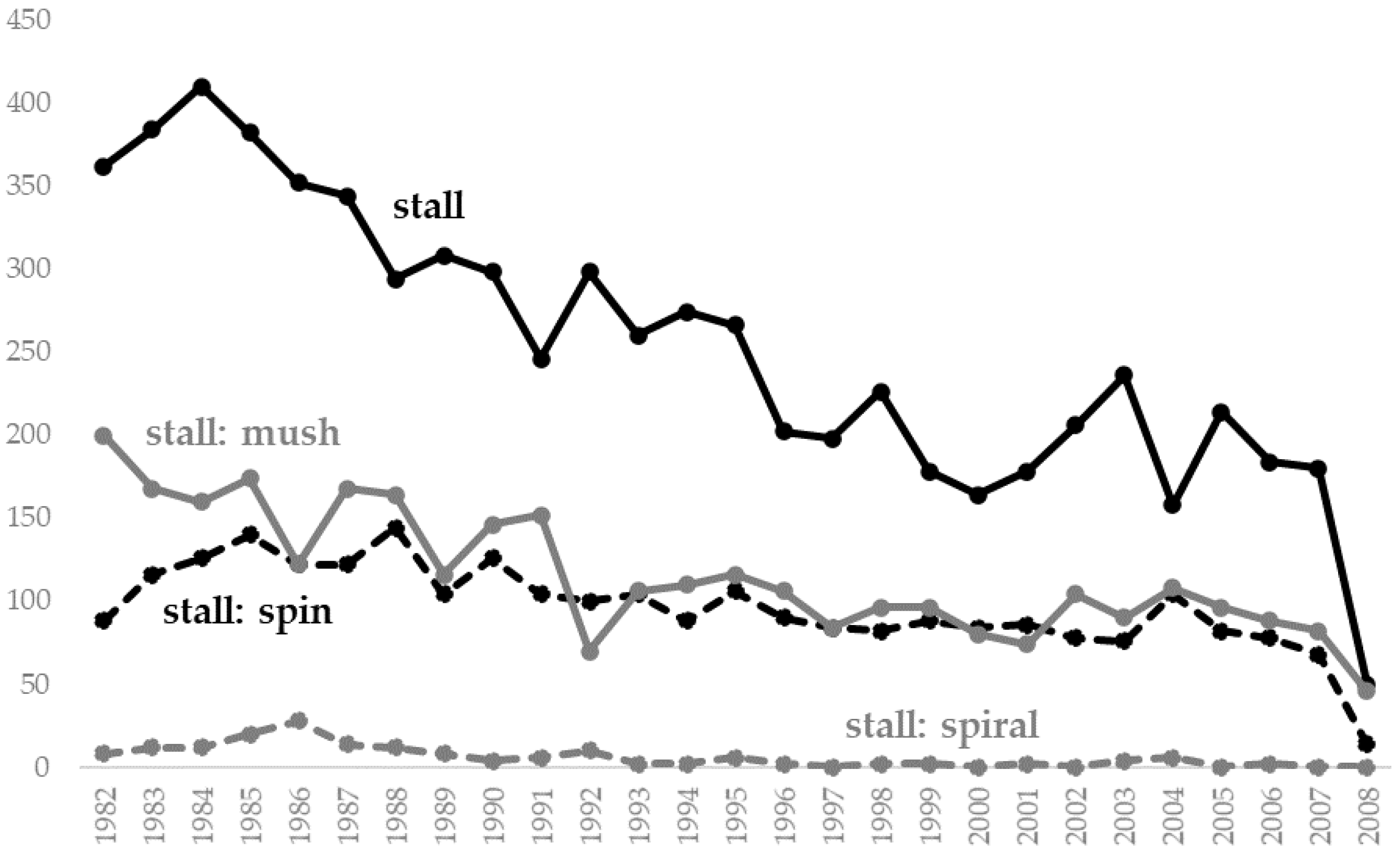
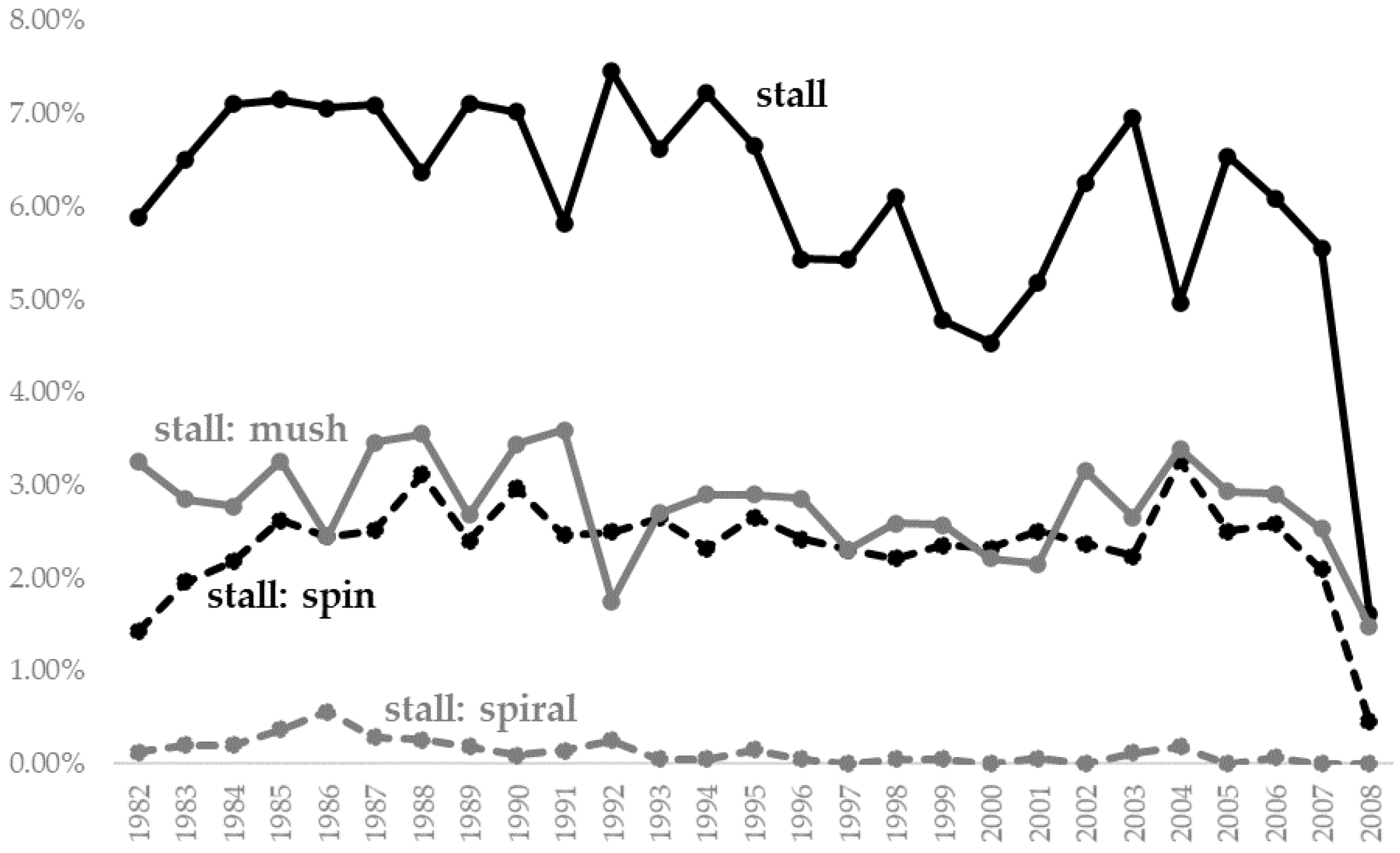

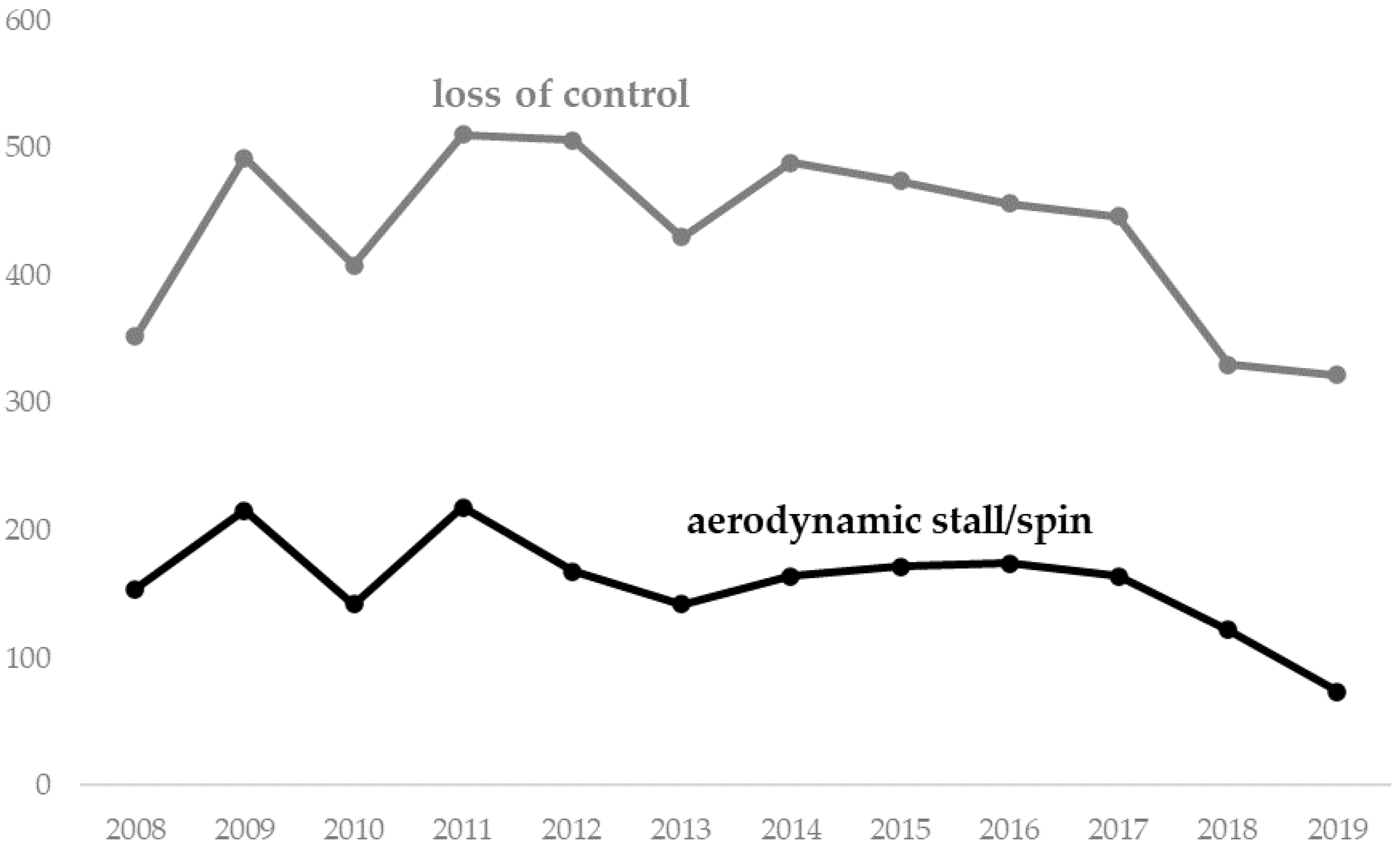

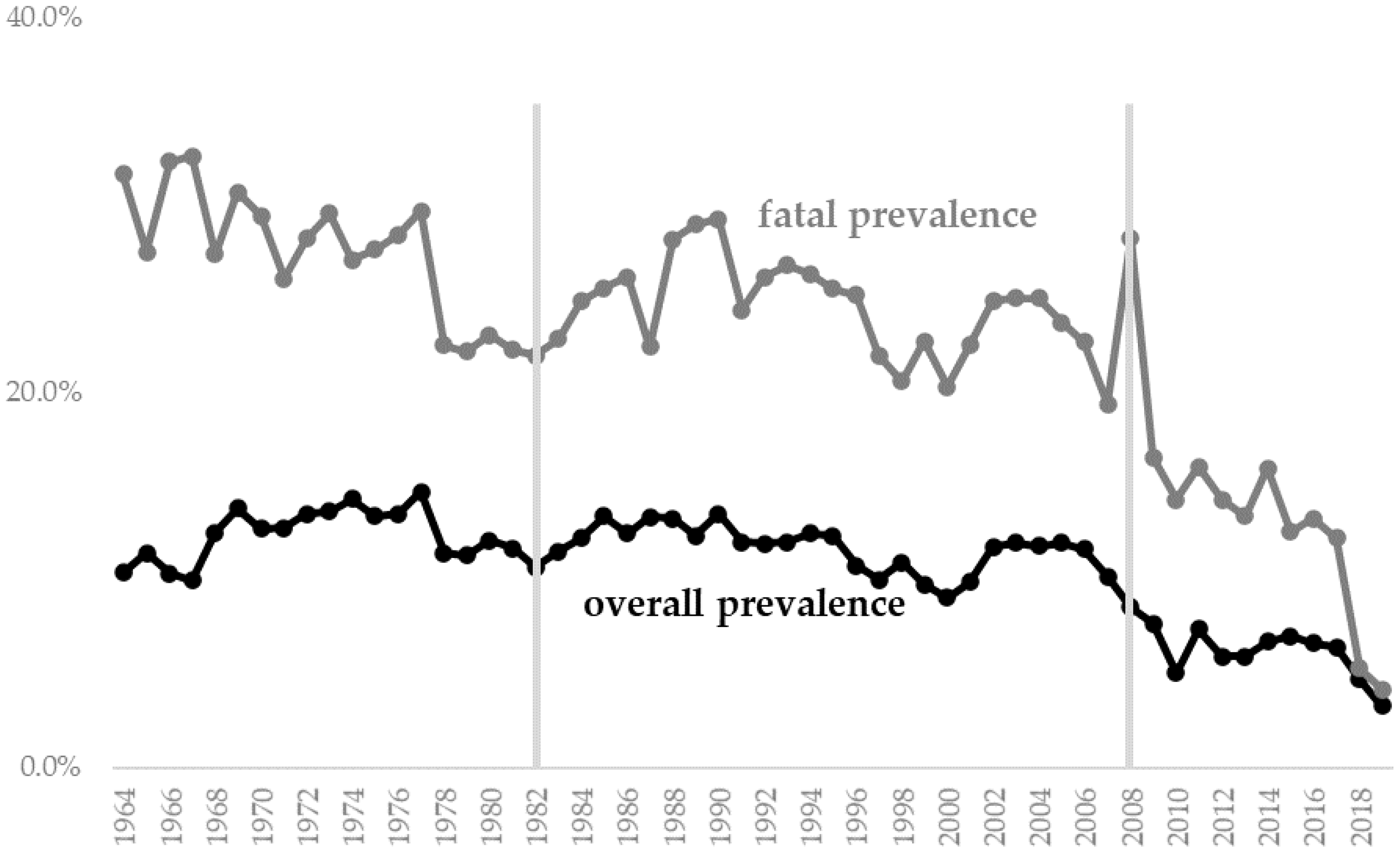
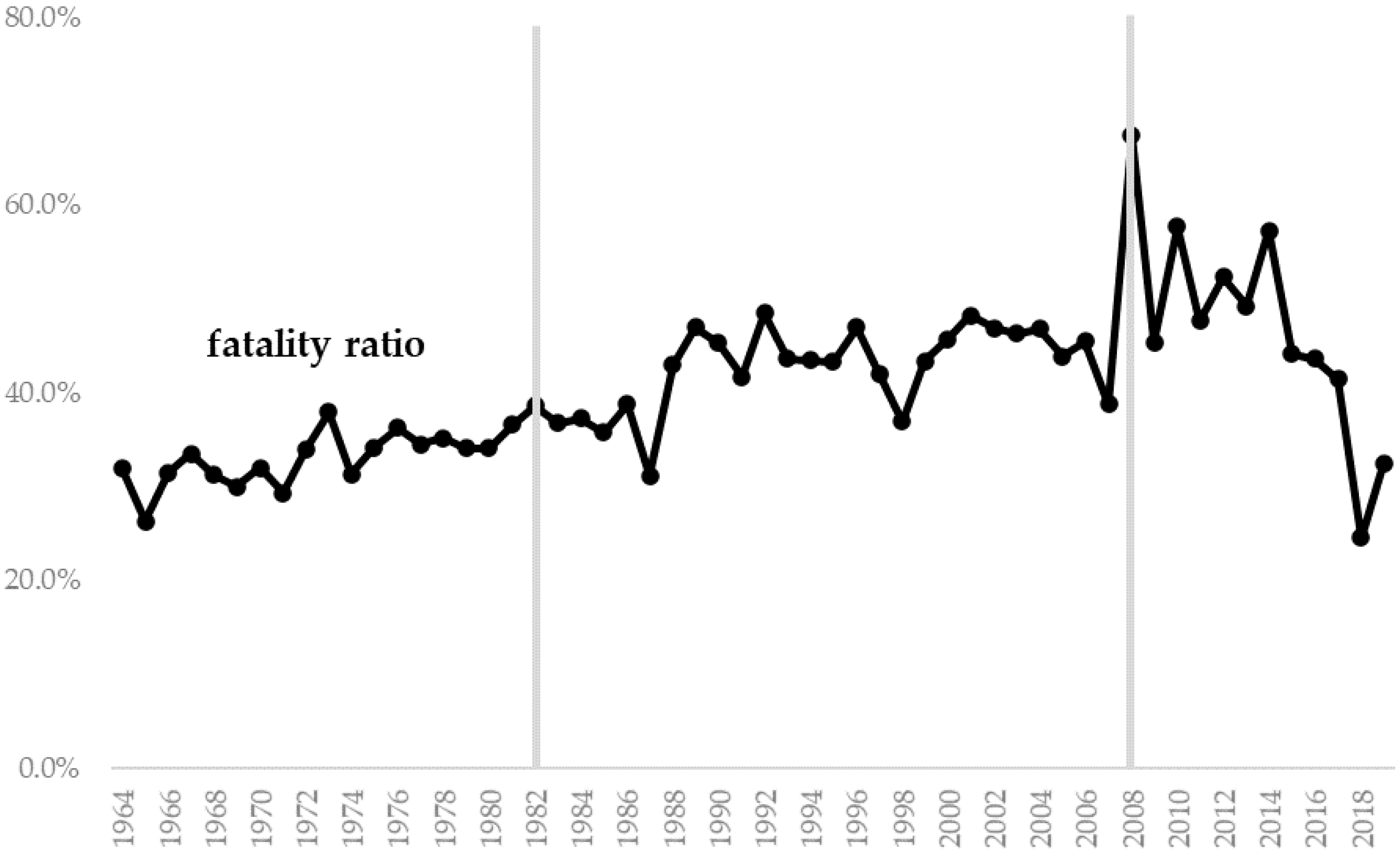
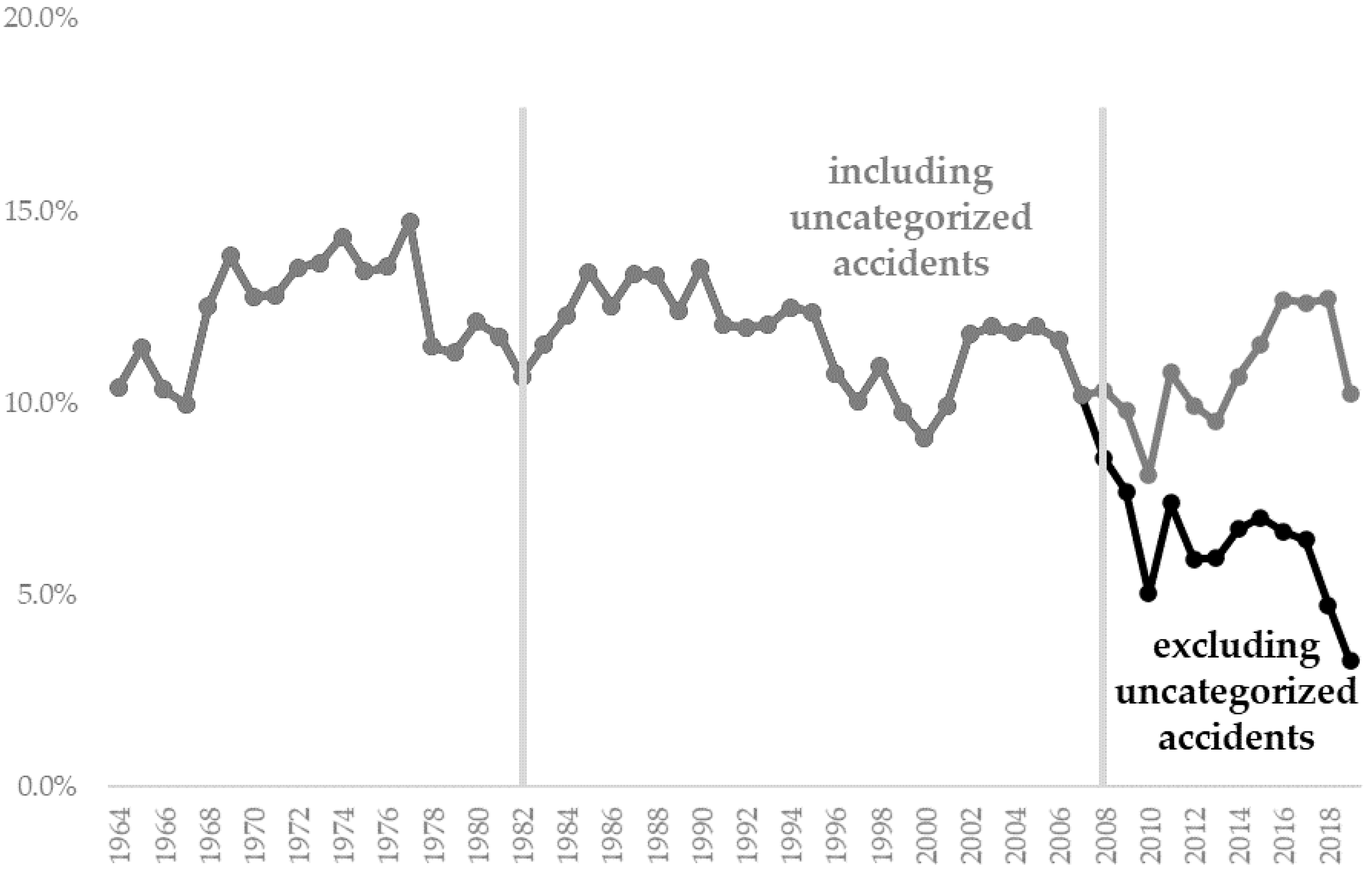
| Occurrence Number | Occurrence Code | Occurrence Description | Subject Code Number | Subject Code | Subject Description | Modifier Code | Modifier Description |
|---|---|---|---|---|---|---|---|
| 1 | 354 | Loss of engine power (partial)—nonmechanical | 1 | 20000 | weather condition | 2202 | carburetor icing conditions |
| 2 | 22304 | carburetor heat | 3133 | not selected | |||
| 3 | 24022 | weather evaluation | 3130 | not understood | |||
| 2 | 220 | In flight collision with object | 1 | 20200 | object | 2522 | wire static |
| 2 | 20200 | object | 2517 | trees | |||
| 3 | 230 | In fight collision with terrain/water | - | - | - | - | - |
| Occurrence Number | Occurrence Code | Phase of Flight Code | Event Code | Occurrence Description | Defining Event? |
|---|---|---|---|---|---|
| 1 | 500270 | 500 | 270 | Approach—Abrupt maneuver | No |
| 2 | 500241 | 500 | 241 | Approach—Aerodynamic stall/spin | Yes |
| 3 | 650470 | 650 | 470 | Uncontrolled descent—Collision with terrain/object (non-CFIT) | No |
| Finding Number | Finding Code | Finding Description | Cause/Factor |
|---|---|---|---|
| 1 | 0106103508 | Aircraft–Aircraft operation/performance/capability–Aircraft capability–Maximum weight–Capability exceeded | Factor |
| 2 | 0106201020 | Aircraft-Aircraft operation/performance/capability–Performance/control parameters–Airspeed–Not attained/maintained | Cause |
| 3 | 0206304044 | Personnel issues–Task performance–Use of equipment/information–Aircraft control–Pilot | Cause |
Publisher’s Note: MDPI stays neutral with regard to jurisdictional claims in published maps and institutional affiliations. |
© 2022 by the author. Licensee MDPI, Basel, Switzerland. This article is an open access article distributed under the terms and conditions of the Creative Commons Attribution (CC BY) license (https://creativecommons.org/licenses/by/4.0/).
Share and Cite
Fala, N. An Analysis of Fixed-Wing Stall-Type Accidents in the United States. Aerospace 2022, 9, 178. https://doi.org/10.3390/aerospace9040178
Fala N. An Analysis of Fixed-Wing Stall-Type Accidents in the United States. Aerospace. 2022; 9(4):178. https://doi.org/10.3390/aerospace9040178
Chicago/Turabian StyleFala, Nicoletta. 2022. "An Analysis of Fixed-Wing Stall-Type Accidents in the United States" Aerospace 9, no. 4: 178. https://doi.org/10.3390/aerospace9040178
APA StyleFala, N. (2022). An Analysis of Fixed-Wing Stall-Type Accidents in the United States. Aerospace, 9(4), 178. https://doi.org/10.3390/aerospace9040178






